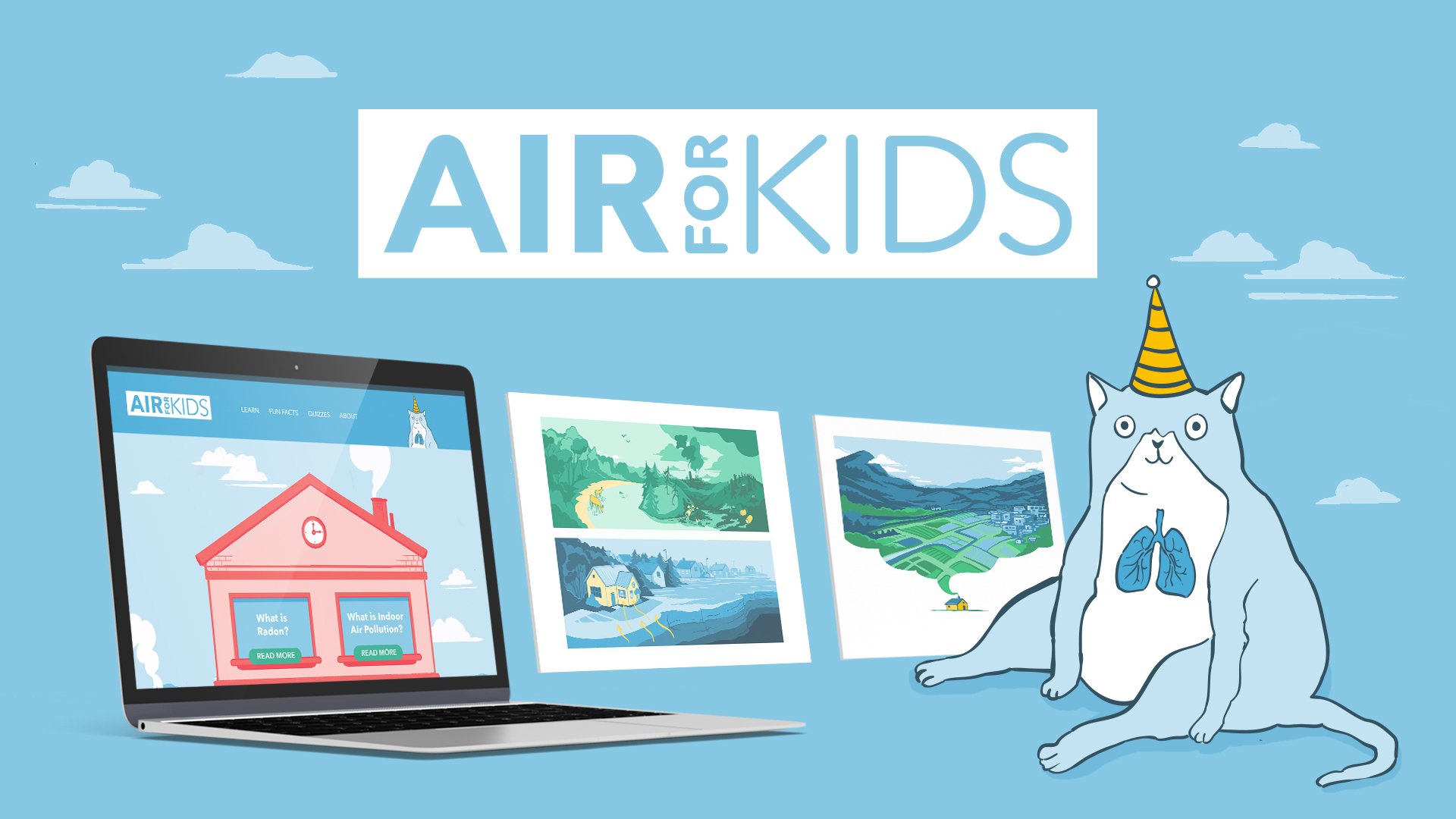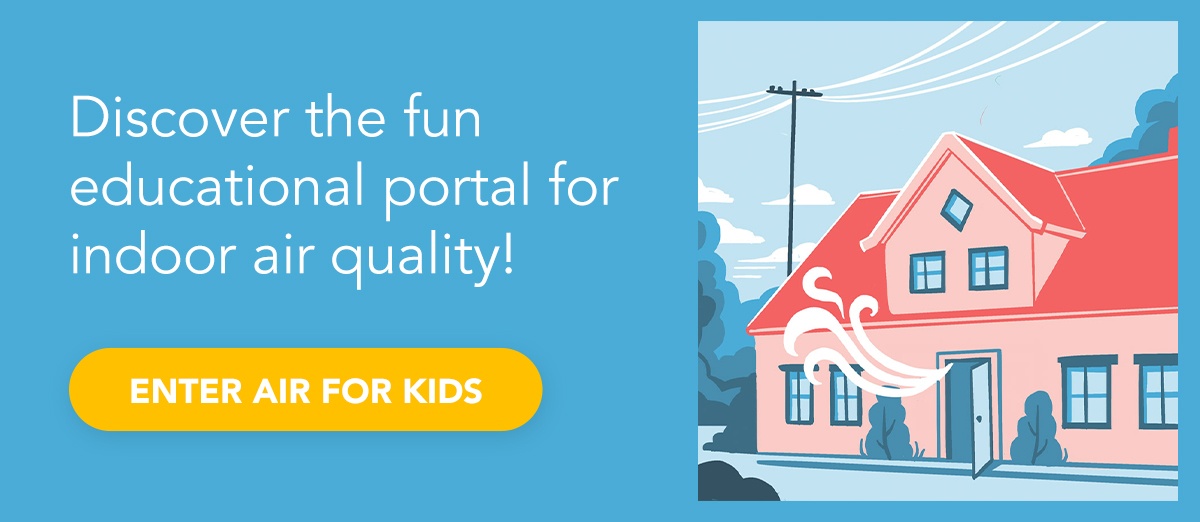How does indoor air quality affect how well young people study? And how can you create the ideal environment for learning at home?
In this blog:
- The challenges of learning at home
- How does air quality affect how kids learn?
- Concentration
- Performance
- Health and wellbeing
- Air for kids
- How to create the best indoor air quality for learning in your home
- Get informed
- Solving indoor air issues
- Key takeaways
The challenges of learning at home
The past year has been tough for kids, as well as their parents and carers, as many had to spend more time learning and studying at home. Aside from the academic challenges this presents, it can be tricky to create an excellent educational environment in a busy home.
Ideally, children need a quiet, tranquil place to learn, but their concentration, performance, and health is also affected by the quality of air they breathe. Whether they’re homeschooling, studying, completing homework, or doing other important activities like music and art, you want your kids to enjoy healthy surroundings that get the best out of them.
Monitoring and improving indoor air quality gives parents and carers a head-start, as they look to provide the best possible environment in the home, both for formal education, like homeschooling and online teaching, and other learning endeavours such as reading, painting, and educational play..jpg)

How does indoor air quality affect how kids learn?
For some time, experts have known that people think more clearly and get better test scores when they learn in an environment with cleaner air. It’s a particularly important issue in schools, because children are considered to be more sensitive than adults to the effects of atmospheric pollution1.
Concentrations of some important pollutants can be up to five times higher indoors than their typical levels outdoors2, and young people in industrialized nations already spent around 85% of their time inside even before the pandemic started3. In fact, as a whole we spent up to 90% of our time indoors4.
There are clear links between indoor air quality and children’s health, as well as their academic performance, but let’s look in detail at how contaminants and elements of air quality affect how kids learn.
 Concentration
Concentration
We know from various studies that better indoor air quality helps us focus and think more clearly, but why might that be?
Excess carbon dioxide is one important factor. As we breathe out CO2 it builds up indoors, particularly in rooms that aren’t well ventilated.
High levels of the gas are linked to complaints like restlessness, drowsiness, sweating, and headaches, which damage our ability to concentrate. Researchers find that people in buildings with higher concentrations of CO2 tend to become dissatisfied, and poor air quality in schools leads to students taking more sick days67.
Temperature is another variable that compromises our ability to learn. We know instinctively that a hot, stuffy room won’t get the best out of kids, and research confirms that children get worse results in school tests when taking papers in warmer weather.
At home, where there are already so many distractions from schoolwork, you won’t want indoor air quality issues to further affect your kids’ concentration. So it’s worth monitoring the air to identify any potential problems. 

Performance
We all think more clearly and perform better in environments where there is optimal indoor air quality. The Harvard T.H. Chan School of Public Health found that improved conditions, including lower levels of CO2, resulted in an impressive 100% improvement in cognitive scores8.
When it comes to education, the evidence that air quality affects performance is particularly compelling. Children perform a range of important tasks better when the air they breathe is improved.
In a study of US elementary schools, kids scored 2.9% higher in math and 2.7% higher in reading when ventilation was increased9. And, in Denmark, turning up the ventilation helped 10 to 12 years olds perform number and language tasks quicker10. In the UK, it was color, picture and word recognition tasks that kids carried out faster and more accurately, with better quality air11.
Health and wellbeing
Some of the more common contaminants in indoor air can cause serious health problems, as well as affecting how we feel and perform.
For example, many household products, including cleaning products, office supplies (like printers, copiers, correction fluids), arts and craft supplies, aerosols, paints, carpets, furniture, and mattresses, contain airborne chemicals (VOCs). If they’re allowed to build up indoors, these toxins can trigger allergies, irritate the lungs, and aggravate asthma when children breathe them in12.
Conditions like humidity, temperature, and air pressure are linked to complaints like irritated eyes, coughs, colds, and headaches13. Indeed, low humidity is also thought to help the spread of infectious diseases like flu and Covid-1914. This focus is sure to grow, as we pay increasing attention to transmissible viruses in the future.
Discover the world of Air for Kids
We’ve discussed how indoor air quality is important for learning, but why not teach your children more about the air they breathe, as part of their educational experience at home?
It’s a vital subject, both for appreciating the world they live in, and for understanding their own health and wellbeing.
Air for Kids is an educational portal featuring a range of fun and informative quizzes and resources, with everything kids need to know about outdoor air, indoor air, pollution, and the environment.
Air for Kids was designed with one goal, air quality education. The air we breathe in is paramount to our health and wellbeing. Not to mention the impact the air has on our planet’s ecosystem.
Access a range of free, high-quality, unbranded educational materials at Air for Kids. Enter Air for Kids
Enter Air for Kids
How to get the best indoor air quality for learning in your home
Get informed
To take control of indoor air quality for home learning, the first step is to understand the air you and your family are breathing. With indoor air quality monitors, you gain a detailed source of real-time and historical information, so you can quickly identify any issues and put them right.
Airthings indoor air quality monitors measure all the necessary data about pollutants like radon, carbon dioxide, and airborne chemicals, as well as key conditions like temperature, humidity, and air pressure, that affect how well children study and feel. The sensors use wireless tech and have long-lasting batteries, so they’re a piece of cake to install.
All the data is accessible through the Airthings dashboard and a mobile app, which provide useful insights so you can act quickly and fix any issues. Once you have this information, though, what type of actions might be necessary to put any problems right? 

Solving indoor air issues
Many issues with indoor air quality for education are solved most effectively with better ventilation. That may involve simply opening a window; or it could mean installing a fan, or using a ventilation system.
For build-ups of CO2, high temperatures, and high humidity, for example, it’s vital to get some air circulating around the room. You might be surprised how quickly it turns a tired, lethargic student into a wakeful, attentive one!
Ventilation can relieve issues with airborne chemicals too, but many products are now available in low-VOC or no-VOC varieties, so check labels carefully. It helps to air out new furniture, rugs, upholstery, or mattresses before they’re used. Also try to keep used cleaning products, varnishes, and solvents away from areas of the home where the children might do schoolwork.
After a sometimes challenging period of home-schooling for both parents and children, some are seeing a slow return to more normal patterns of school attendance. Undoubtedly though, the home will continue to be an important learning environment for studying, homework, remote lessons, and a host of other educational purposes in the future.
An indoor air quality monitor gives you the information you need to ensure your children are breathing air that helps them think clearly, perform at their best, and learn more effectively. 

Key takeaways
- The home doubles as a learning environment for many children, from ho. They need a quiet place to concentrate on their work, but their performance is also affected by the air they breathe.
- High levels of carbon dioxide are linked to complaints like drowsiness, headaches, and restlessness, that damage concentration.
- Children perform educational tasks consistently better when ventilation rates are increased. There is also evidence that test scores are worse under hot conditions.
- Common indoor air pollutants, like airborne chemicals (VOCs), are linked to health problems like allergies and asthma.
- By monitoring and controlling indoor air quality, you can ensure your child has the optimal environment to perform at their best and learn more effectively.
Sources:
1. https://pubmed.ncbi.nlm.nih.gov/21621987/
2. https://www.huffpost.com/entry/how-employee-productivity_b_5620941?guccounter=1
3. https://ehp.niehs.nih.gov/doi/pdf/10.1289/ehp.110-a298
4. https://www.epa.gov/report-environment/indoor-air-quality#:~:text=Americans%2C%20on%20average%2C%20spend%20approximately,higher%20than%20typical%20outdoor%20concentrations
5. https://www.healthline.com/health/hypercapnia#symptoms
6. https://www.ncbi.nlm.nih.gov/pubmed/15330777
7. https://pubmed.ncbi.nlm.nih.gov/25789698/
8. https://ehp.niehs.nih.gov/doi/10.1289/ehp.1510037
9. https://www.ncbi.nlm.nih.gov/pubmed/21029182
10.https://www.gwern.net/docs/co2/2015-stafford.pdf
11. https://www.worldgbc.org/sites/default/files/Better%20Places%20for%20People%20-%20Schools%20Briefing%20Notes%20-IAQ.pdf
12. https://www.healthlinkbc.ca/healthlinkbc-files/air-quality-VOCs
13. www.sciencedirect.com/science/article/pii/S1438463917306946#sec0095
14. https://msystems.asm.org/content/5/2/e00245-20










.webp)

